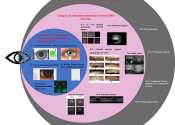A contact lens (also known simply as a contact) is a corrective, cosmetic, or therapeutic lens usually placed on the cornea of the eye. Modern soft contact lenses were invented by the Czech chemist Otto Wichterle and his assistant Drahoslav Lím, who also invented the first gel used for their production.
Contact lens usually serve the same corrective purpose as glasses, but are lightweight and virtually invisible—many commercial lenses are tinted a faint blue to make them more visible when immersed in cleaning and storage solutions. Some cosmetic lenses are deliberately colored to alter the appearance of the eye.
It has been estimated that 125 million people use contact lenses worldwide (2%), including 28 to 38 million in the United States and 13 million in Japan. The types of lenses used and prescribed vary markedly between countries, with rigid lenses accounting for over 20% of currently-prescribed lenses in Japan, Netherlands and Germany but less than 5% in Scandinavia.
People choose to wear contact lenses for many reasons, often due to their appearance and practicality. When compared to spectacles, contact lenses are less affected by wet weather, do not steam up, and provide a wider field of vision. They are more suitable for a number of sporting activities. Additionally, ophthalmological conditions such as keratoconus and aniseikonia may not be accurately corrected with glasses.









